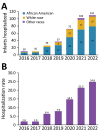Spike in Congenital Syphilis, Mississippi, USA, 2016-2022
- PMID: 37735714
- PMCID: PMC10521607
- DOI: 10.3201/eid2910.230421
Spike in Congenital Syphilis, Mississippi, USA, 2016-2022
Abstract
In Mississippi, USA, infant hospitalization with congenital syphilis (CS) spiked by 1,000%, from 10 in 2016 to 110 in 2022. To determine the causes of this alarming development, we analyzed Mississippi hospital discharge data to evaluate trends, demographics, outcomes, and risk factors for infants diagnosed with CS hospitalized during 2016–2022. Of the 367 infants hospitalized with a CS diagnosis, 97.6% were newborn, 92.6% were covered by Medicaid, 71.1% were African American, and 58.0% were nonurban residents. Newborns with CS had higher odds of being affected by maternal illicit drug use, being born prematurely (<37 weeks), and having very low birthweight (<1,500 g) than those without CS. Mean length of hospital stay (14.5 days vs. 3.8 days) and mean charges ($56,802 vs. $13,945) were also higher for infants with CS than for those without. To address escalation of CS, Mississippi should invest in comprehensive prenatal care and early treatment of vulnerable populations.
Keywords: Mississippi; Treponema pallidum; United States; bacteria; congenital syphilis; health disparities; neonatal illnesses; prematurity.
Figures



Similar articles
-
Congenital syphilis--United States, 2002.MMWR Morb Mortal Wkly Rep. 2004 Aug 13;53(31):716-9. MMWR Morb Mortal Wkly Rep. 2004. PMID: 15306757
-
Congenital syphilis: Public health failures are blamed for "alarming" increase in cases in Mississippi.BMJ. 2023 Sep 21;382:2180. doi: 10.1136/bmj.p2180. BMJ. 2023. PMID: 37734756 No abstract available.
-
IgM antibody to Treponema pallidum in cerebrospinal fluid of infants with congenital syphilis.Am J Dis Child. 1992 Oct;146(10):1171-5. doi: 10.1001/archpedi.1992.02160220057022. Am J Dis Child. 1992. PMID: 1415044
-
Syphilis in Children.Infect Dis Clin North Am. 2018 Mar;32(1):129-144. doi: 10.1016/j.idc.2017.11.007. Infect Dis Clin North Am. 2018. PMID: 29406973 Review.
-
Syphilis in Pregnancy.Obstet Gynecol. 2020 May;135(5):1121-1135. doi: 10.1097/AOG.0000000000003788. Obstet Gynecol. 2020. PMID: 32282589 Review.
Cited by
-
A Retrospective Cohort Study on Treponema pallidum Infection: Clinical Trends and Treatment Outcomes for Congenital Syphilis in Guangxi, China (2013-2023).Infect Drug Resist. 2024 Jun 12;17:2351-2359. doi: 10.2147/IDR.S467426. eCollection 2024. Infect Drug Resist. 2024. PMID: 38882653 Free PMC article.
-
Social Factors Associated With Congenital Syphilis in Missouri.Clin Infect Dis. 2024 Sep 26;79(3):744-750. doi: 10.1093/cid/ciae260. Clin Infect Dis. 2024. PMID: 38734971 Free PMC article.
-
Brief Report: Trends of Congenital Syphilis among Neonates in Canada 2012-2023.J Pediatr Clin Pract. 2025 Apr 30;16:200146. doi: 10.1016/j.jpedcp.2025.200146. eCollection 2025 Jun. J Pediatr Clin Pract. 2025. PMID: 40474941 Free PMC article.
-
Ischemic stroke as a presenting feature of neurosyphilis in an immunocompetent adult and attained complete recovery following treatment: a case report and review of the literature.J Med Case Rep. 2025 Apr 14;19(1):174. doi: 10.1186/s13256-025-05090-9. J Med Case Rep. 2025. PMID: 40229892 Free PMC article. Review.
References
-
- Centers for Disease Control and Prevention. Congenital syphilis: main clinical manifestations in infants [cited 2023 Feb 2]. https://www.cdc.gov/ncbddd/birthdefects/surveillancemanual/quick-referen...
-
- Centers for Disease Control and Prevention. Sexually transmitted disease surveillance 2021. [cited 2023 Feb 2]. https://www.cdc.gov/std/statistics/2021/default.htm
-
- Agency for Healthcare Research and Quality. Healthcare Costs and Utilization Project (HCUP). Databases information. Rockville, MD. 2022. [cited 2023 June 25]. https://www.ahrq.gov/data/hcup/index.html
Publication types
MeSH terms
LinkOut - more resources
Full Text Sources

